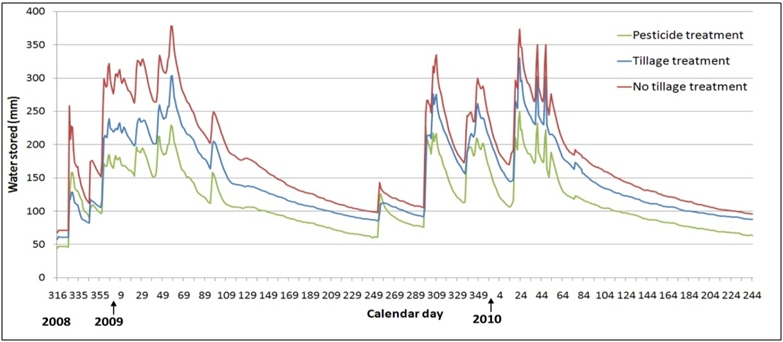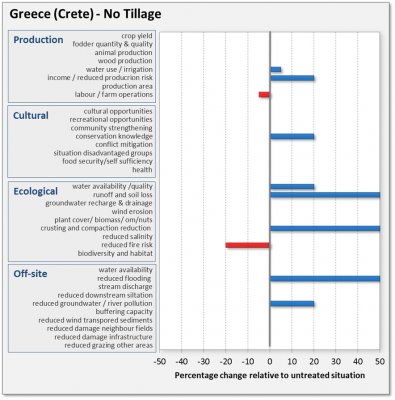|
The eastern and central part of the Greek island Crete is suffering from land degradation problems, while the rest of the island is highly sensitive to desertification. Soil erosion due to surface runoff and tillage operations, collapse of terraces, overgrazing, salinization of lowlands, and overexploitation of ground water are the major processes of land degradation in the area. A lot of forested areas were converted into cultivated land In the last century. Overgrazing and fires further destroyed the natural vegetation cover and prevented its regeneration.
Olive groves are an important form of land use in the area, but have various degrees of due to the different land management practices. Farmers perceive a herb cover as a competition for water for the Olive trees and keep the field clean and bare below the trees. A minimum tillage experiment with and without herbicides was carried out to see if it is possible to maintain a soil cover, restore the natural soil structure, promote infiltration and reduce runoff and helps in minimizing soil losses.
| Experiments: combining minimum tillage with levels of herbicide application |
The experimental field is located on moderately steep slope (slope gradient 17%) which is prone to erosion. The soil is moderately deep (55-65 cm). The experimental setup included three management practices prevailing in the area with two replicates:
|
(a) no tillage – no herbicide application, (b) no tillage – herbicide application, and (c) tillage operation – no herbicides with soil cultivated perpendicular to the contour lines at depth 20 cm using a disk harrow. The plots are of the size 3x5m².
Tipping buckets were installed at the bottom of the plots to collect surface runoff. Also there are facilities for collecting soil sediments. Meteorological variables are measured at the same field using an automatic station (see photo). The experimental station is remotely controlled from the laboratory of Soils in the Agricultural University of Athens.
|
 |
One time measurements were carried out such as: texture and stoniness, organic matter, aggregate stability, etc.
 |
Repeated measurements were conducted such as soil moisture with permanent installed TDRs, soil temperature, while sediment loss was measured every rainfall event, and surface water runoff every 5 minutes. |
 |
The experiments in the olive grove show significant differences in surface runoff and sediment loss as a result of applying different land management practices. The highest amounts of surface runoff have been measured in the experimental plot subjected to tillage operation with 44.7 mm and 7.9 mm of runoff recorded in the first and second year of study, respectively. Under no tillage and no tillage-herbicides application the surface runoff reduced by approximately 1/4 times. The lowest runoff was recorded under the no tillage land management practices since soil was fully covered with vegetation (weeds, top left photo).
Soil losses show similar trends. The soil loss was highest in the tillage land management practices, especially in the first year of measurements. This is due to high rainfall amount in that year. Sediment loss in this management practice ranged from 44.2 to 255.9 kg ha-¹ yr-¹ during the two year period of measurements (see figure below).
The no-tillage land management practices also reduce production costs by minimizing cost involved in man power.
The three treatments: minimum tillage, no herbicide (top), minimum tillage with herbicide (middle), conventional (bottom)
|

Recorded runoff is consistently higher in the tillage plot

Totals in runoff and sediment losses for the two years. Year 2(2010) was a wetter year.
 |
The results are evaluated from a production, socio-cultural and economic point of view. The bars express the estimated or measured percentage of change with respect to the reference situation. This change can be positive (blue) or negative (red). Note that this evaluation is based on the experiments, on the long term experience of the coordinating team in this area and on consultations with the farmers. |
- Many of local farmers have visit the monitoring site and observed the work carried out. They have many times discussed the issue of desertification and the measures for protecting the land from further degradation in local meetings. They have considered the applied land management practices and included in the agricultural program of “Integrated Land Management of Olive Groves” for receiving higher subsidies.
- The benefits are related to: (a) lower cost production of olive oil, (b) higher income due to the application of integrated land management of olive groves for protection of the environment. The application of no-tillage or minimum tillage land management practices did not require additional cost for implementation.
- On the other hand thereis still a discussion whther the herb layer gives water competition for the olive trees, which has not yet been resolved. Moreover in a very dry year the dried out herb layer could give an extra wildfire risk.
|
The application of the appropriate land management practice can greatly affects land protection and reduction in runoff and erosion, consistently over the two years. The experiment shows that the no tillage – no herbicides land management results in minimizing sediment loss due to low surface runoff. Added ecological effects are higher soil water storage, lowering soil temperature, higher biodiversity. This is confirmed by a longer experience in the area and results from previous studies.
|
|
Several stakeholders have accepted this type of land management practice due to low olive oil price. It may be if the olive price rises, a reversion to traditional tillage is seen because farmers want to minimize production risk. There are clear economic benefits as the reduced tillage reduces labour and fuel costs.
|
|
An important bottleneck is the lack of knowledge transfer by the Greek Ministry of Agriculture on new sustainable land management practices and decreasing cost production.
|
|










